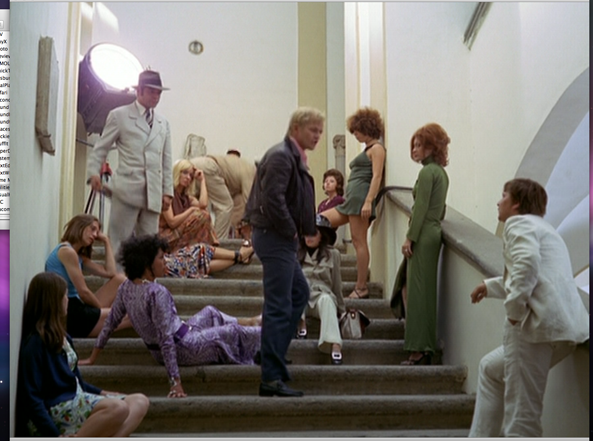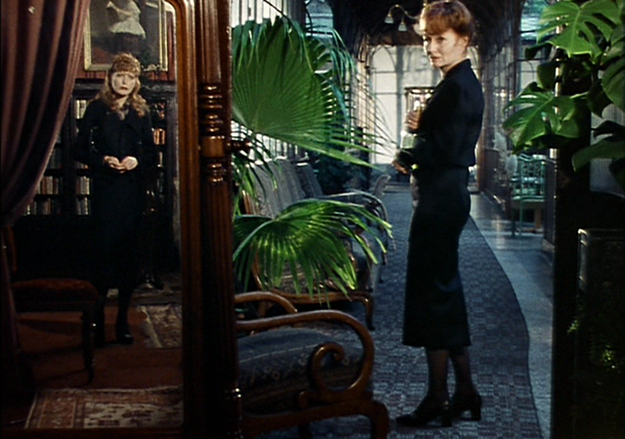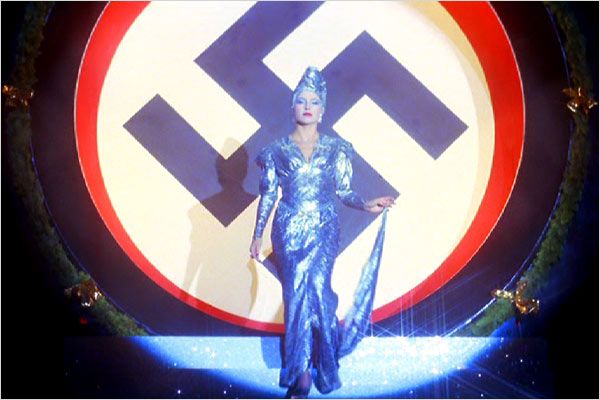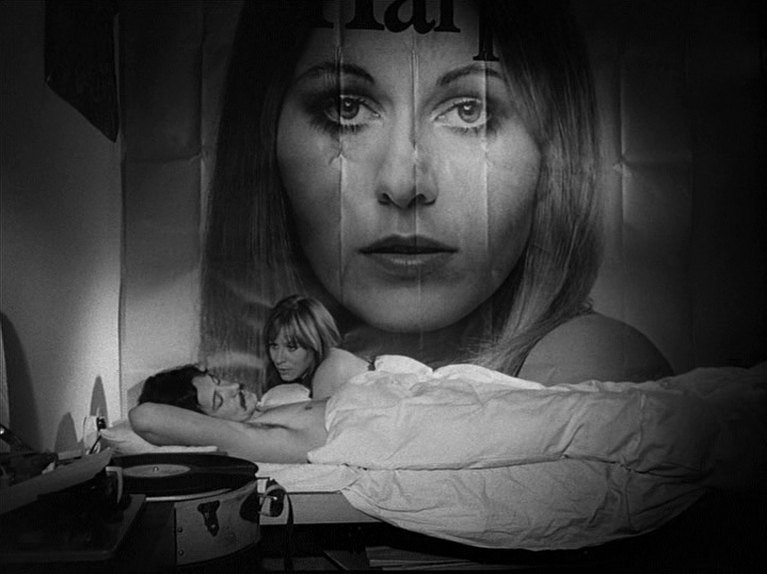#146
Post
by Rayon Vert » Sun Nov 07, 2021 5:58 pm
The Third Generation. This is very much in spirit, form and tone(s) a companion to In a Year with 13 Moons. The preceding film was already bringing Godard to mind, but it’s even more the case here (which knives already observed earlier). One thinks especially of later Godard in terms of the near-constant audio double- and triple-layering that splits our attention (which gets near-incomprehensible in translation, since we have the additional competition of subtitles, and of course only portions of the different “texts” get illuminated this way), as well as all the other metafictional tricks going on and the alternation of deadly political and philosophical seriousness to utterly mad, acidic black comedy - all of this adding up to make different conventional audience engagement and identification impossible.
And that’s without mentioning how the way the film’s setting among these would-be revolutionaries strongly refers back to La Chinoise. Godard was arguably at once making fun of and admiring his university students; here Fassbinder is sympathetic with the longings of what motivates these older, now-ensconced-in-boring-professional-and-family-life bourgeois characters but is lucid about how the patterns they seek to change have already determined the limits of what they’re able to imagine (as represented in part in the behaviour among them – this is a real ensemble work, and there’s a potential parallel here with Beware of a Holy Whore where the participants in supposedly critical, lucid filmmaking carry actually carry over the same lack of lucidity in their real lives).
I agree with zedz that it’s hit and miss here. It’s striking how the film becomes so manic and zany at the end – one moment that stood out for me in this sense was where Fassbinder makes an overly obvious parallel with the authoritarian police commissioner and his nation’s past when we see him beating up and intimidating Bernard to get him to give an address: “We have methods you cannot possible imagine – you will talk”, a wink to the old Nazi character cliché “ve haf vays of making you talk”.
But whatever the imperfections in the execution, there’s an incredible richness of ideas in both content and form in these two works that definitely begs for repeated and close viewings and analysis. (I’d love to have a proper presentation of this film, with illuminating extras and something like an Adrian Martin commentary, like the one he made for Beware of a Holy Whore.) And the despair, bordering on cynicism, and the focus on death as the only possible, or desirable, ending or escape (right off the bat the subtitle lets us know this is A comedy in six parts about party games full of tension, excitement and logic, cruelty and madness, similar to fairy tales told to children to help them bear their lives unto death,which is a followed in the first scene by a playing of the ending of Bresson’s Le Diable probablement), seems to reach a peak here.
I really find Thomsen very compelling in his writing on this film, which he considers perhaps the director’s most radical and important. Schopenhauer’s ideas are really foregrounded in this film (just as they were very present also in the preceding In a Year with 13 Moons), starting with the revolutionaries/terrorists’ repeated slogan “the world as will and imagination”. Thomsen summarizes how the philosophers’ ideas are used here thusly: “(T)he world is the way that will and imagination make it. If the existing world nevertheless does not correspond to what we have imagined and our will is not strong enough to assert our ideas in the world, we still have the fragile possibility of existing in art or in dreams (…) “(A)rt and dreams allow utopia and the will to life to be expressed anew again and again, defying the prevailing conditions of existence.” (p. 264) Art is the only – temporary – escape. He then argues that just like the characters in the film, the terrorists, turn their ideas into an aesthetic expression, i.e. street theater, because the world can’t be changed in any other way, Fassbinder’s own film, through its “irritating” form, expresses that same idea that survival is possible only in the “aesthetic will to form”. More specifically, the film itself “takes up the madness of society into its formal language and simultaneously distances itself”, and in this way expresses the fact that escape is not possible (which by contrast a linear narrative would have suggested), while also asserting that a kind of survival is possible – until the eventual true liberation that is death – through the aesthetic putting-into-form of this lucid awareness of this very fact that survival in this society is impossible (p. 263).
To me, those ideas appear a potential key to understand not just this specific film – although it may be the clearest expression of them (and therefore why Thomsen considers it the most important) –, but Fassbinder’s general artistic and philosophical manifesto in these later years when his hopelessness and quasi-misanthropy are at their highest. His editor Juliane Lorenz seemed to make a similar point, in the interview that’s featured on the Artificial Eye DVD for In a Year with 13 Moons, when she says that the only way Fassbinder could survive and overcome Armin Meier’s death was to create the film that he made. Will to form again.
Now if you’ll pardon this long-ish digression…
I don’t know if this makes Fassbinder’s cinema at this point in history unique or radically original in its ideas, but of course the vision communicated is not entirely unique or new in the history of ideas and art in general. If anything, it places him in direct continuity with a whole trend of post-Romantic artistic and philosophical thought that’s initiated in the 19th century (and has continued to manifest into the present day, as part of our modernity) and in which interestingly the German tradition is particularly noteworthy.
I’m inspired here by a book I’ve cherished for a few decades, philosopher Charles Taylor’s Sources of the Self: The Making of the Modern Identity, and more to the point here the chapter “Visions of the Post-Romantic Age”. This background material couldn’t help being brought to my mind as I watched these films while reading Thomsen’s articulation of the ideas they convey. In a more secularized (Western) society, say at the turn of the 19th century or thereabouts, when religion was no longer the only horizon available for identifying what was most highly valued, the Romantics initiated a new, spiritual exaltation of art: art, conceived as epiphanic, had a spiritual significance (and it can be argued that this notion culturally is still very much with us today). Realizing an epiphany is achieving or recovering contact with what Taylor calls a “moral source”, something that fosters, and/or itself constitutes, a spiritually significant fulfilment or wholeness.
Taylor then traces how, in various transformations of Romanticism in the 19th century, there are reversals of some of its core features, while this exaltation of art, however, continues to thrive and develop, and this where I find Fassbinder’s mature thought or artistic vision finds a certain kinship. The author brings up the French poet Baudelaire’s vision as one of the key transformations. For Baudelaire, unlike the Romantics, nature is no longer an idealized moral source, something with which (out there or in ourselves) we can connect to in order to realize this spiritual connection. Instead the world is ugly, ordinary and fallen. But at the same time Baudelaire (unlike the Realists), and in continuity with the Romantics, does not deny the spiritual but constantly affirms it. There is a “transcendent aspiration to purity”, but one that artifice provides – art and the imagination have the power to correct and purify nature, and in epiphany reveal a spiritual world lying behind the fallen world (p. 436-40). As with the Romantics, the antidote to social-spiritual problems lives in art.
Interestingly, Taylor then presents Schopenhauer’s equally misanthropic but even more pessimistic thought as yet another key transformation of Romanticism, where once again key aspects of the Romantic worldview are negated, while some, like its attitude to art, is reaffirmed. Taylor summarizes the German philosopher’s thought in this regard in the following way: Schopenhauer also articulates, like the Romantics, the notion of nature as a source of power. But unlike the Romantics it is not a spiritual source of good, it is completely amoral – “nothing but wild, blind, uncontrolled striving, never satisfied, incapable of satisfaction, driving us on, against all principles, law, morality…”, with its only aim being to perpetuate itself (p. 442). A character in The Third Generation quotes Schopenhauer as asserting that the existence of a human being is no important than that of a stone.
However, there are a few “positive” dimensions in this philosophy, and one of them that’s key is that Schopenhauer offered a notion of transfiguration through art. Although people cannot achieve a total liberation, “we can manage to quiet the will in us when we grasp the Ideas, the eternal forms which underlie the particular examples we meet in the world of objectifications of the will on their various levels. We encounter these principally in art.” (p. 443)
Here’s where the connection with these later works of Fassbinder reveals itself most strongly. I’d argue that one key difference with Fassbinder, however, is that his stance isn’t ultimately metaphysical – he isn’t damning the universe or whatever forces are behind nature, like Baudelaire or Schopenhauer, but the socio/political/psychological patterns that condition human life. So that his vision isn’t as absolutely misanthropic or pessimistic as those writers. It’s human society, or how it’s conditioned to have become, that is the nightmare. But practically, in terms of human existence, the results are nevertheless the same since there aren’t really solutions to those problems, and it isn’t really possible to escape, so that again, by this point in Fassbinder’s thought, the only means of survival (or seeing/realizing the good?) is, temporarily, through an expressive, aesthetic transfiguration.
I’ll leave off these reflections here, but I do find it interesting to see how Taylor goes on to suggest how Schopenhauer’s influence was massive in late 19th century Europe, including over a lot of German-Austrian writers and artists who fostered their own “theories of transfiguration through creative expression” (p. 444). For the young Nietzsche, art “justifies” reality. For Wagner, the world is transfigured through tragedy, which makes it worthwhile. With Mahler, the Schopenhauer notions are developed in Christian terms). Similar ideas are at work of author Thomas Mann. (It’s interesting to note here that a major piece of music early on in In a Year of 13 Moons is the use of the 4th Adagietto movement of Mahler’s 5th Symphony, and that, as related by Juliane Lorenz, Fassbinder took it from Visconti’s filmed adaptation of Mann’s Death in Venice.) So that as radical as Fassbinder’s artistic vision in the late 1970s is for German cinema, and maybe cinema in general, it arguably finds its place within a long German, and more largely European, artistic and philosophical tradition.




